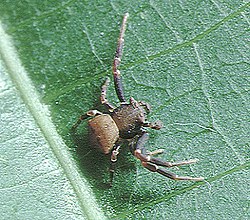Thomisus
| Thomisus | |
|---|---|

| |
| Thomisus onustus capturing a bee | |
| Scientific classification | |
| Kingdom: | |
| Phylum: | |
| Class: | |
| Order: | |
| Suborder: | |
| Section: | |
| Superfamily: | |
| Family: | |
| Tribe: | |
| Genus: | Thomisus Walckenaer, 1805
|
| Type species | |
| Thomisus onustus Walckenaer, 1805
| |
| Species | |
|
T. kitamurai | |
| Diversity | |
| 136 species | |


Thomisus is a genus of crab spiders (family Thomisidae) with more than 100 species described. The genus includes species that vary widely in their ecology, but the best known crab spiders are those species that people call the flower crab spiders, because they are ambush predators that feed on insects visiting flowers. The flower crab spiders are the species for which the popular name was coined, because of their crab-like motion and their way of holding their front legs in an attitude reminiscent of a crab spreading its claws as a threat.
Description and habits
As with most Thomisidae species, Thomisus exhibit sexual size dimorphism: females are four to ten mm in length, whereas males are only two to seven mm. Many are brightly colored, usually matching the color of the flower in which they are waiting in ambush.[1] Not all species are flower-dwelling, but among those that are, at least some species can change their colour over a period of some days to match the flower colour.[2] Studies suggest that bees are inclined to avoid a flower that contains a spider-sized object of a non-matching colour; whether this is specifically a mechanism for avoiding crab spiders, or simply that they are not attracted to flowers whose nectar guides are obscured however, is a more difficult question.[3] The colour changes that such species can achieve are typically in ranges of white, pink, and yellow.
For example in the Thomisus spectabilis species, the method of camouflage is similar to the Misumena vatia except the Thomisus spectabilis blend in with their environment while being visible to their prey, but not their predators. This species of crab spiders are UV reflective while the flower is UV absorbing creating a contrast between the spider and flower through the eyes of the pollinator.[4] The contrast created greatly attracts pollinators such as honeybees. This evolutionary method of camouflage increased the likelihood the crab spiders encountered prey, which in turn effects the fitness of the crab spiders. Due to the increased encounter rate of prey the spiders are able to focus energy on reproduction therefore leading to increased fitness in the spiders. The evolutionary method of camouflage greatly increases the survivability and fitness of crab spiders.
Distribution




The distribution of Thomisus species is almost worldwide, with the notable exception of most of South America.[5]The world spider catalog Although Thomisus species can be found almost anywhere on earth, most species occur in the tropics and the warmer regions of the Old World, with fewer species in the region from New Guinea to Australia and the New World. Only T. guadahyrensis is known from South America, and only in Peru.
Species
|
|
References
- ^ Murphy, Frances & Murphy, John (2000). An Introduction to the Spiders of South-East Asia. City: Malaysian Nature Society. ISBN 983-9681-17-6.
{{cite book}}: CS1 maint: multiple names: authors list (link) - ^ Filmer, Martin (1997). Southern African Spiders. City: BHB International / Struik. ISBN 1-86825-188-8.
- ^ Reuven Dukas and Douglass H. Morse ; Crab spiders affect flower visitation by bees ; OIKOS 101: 157–163, 2003
- ^ Gawryszewski, F. M., A. L. Llandres, and M. E. Herberstein. "Relationship between colouration and body condition in a crab spider that lures pollinators." Journal of Experimental Biology 215, no. 7 (2012): 1128-1136.
- ^ Platnick, Norman I. (2008): The world spider catalog, version 8.5. American Museum of Natural History.
Supplementary reading
- Murphy, Frances & Murphy, John (2000): An Introduction to the Spiders of South East Asia. Malaysian Nature Society, Kuala Lumpur.
- Platnick, Norman I. (2008): The world spider catalog, version 8.5. American Museum of Natural History.
